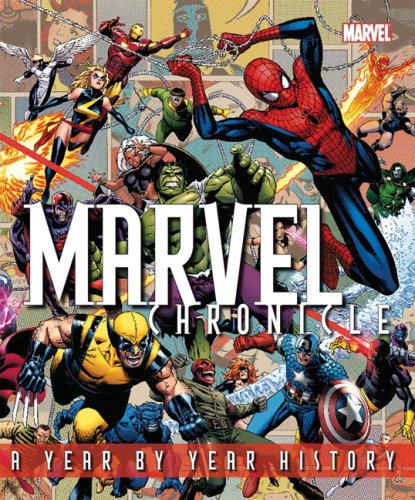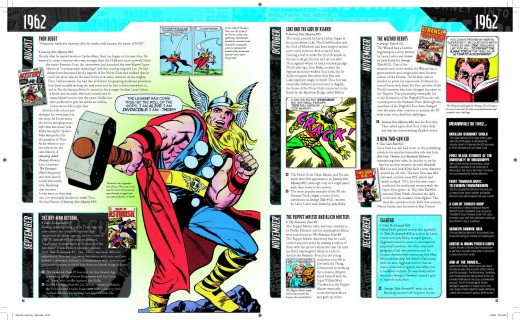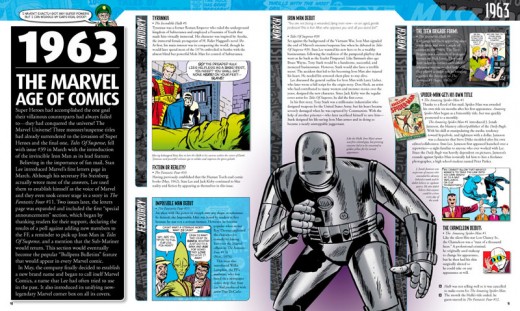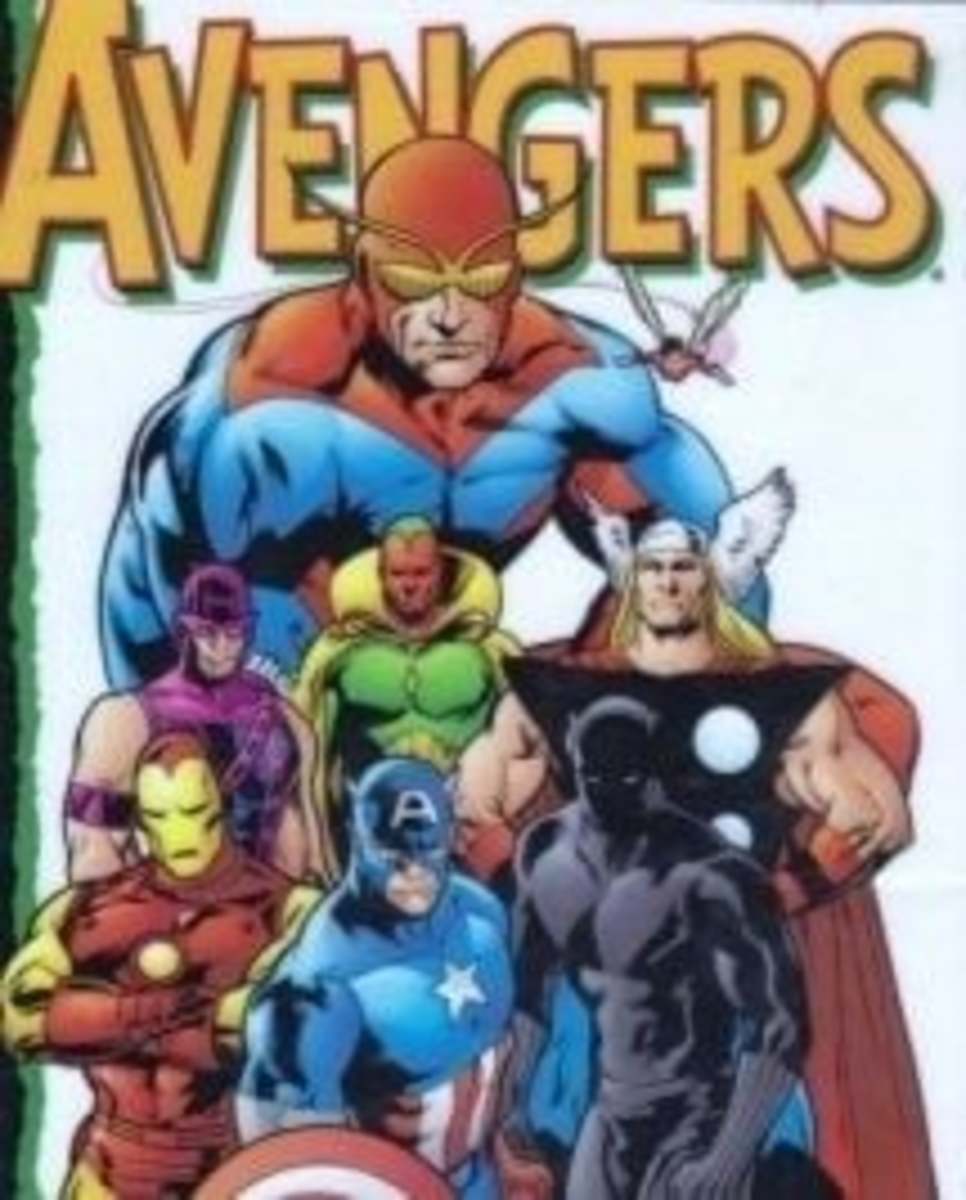Buy "Marvel Chronicle: A Year by Year History" from Marvel Comics and DK Publishing
Marvel Chronicle: a book review
I like to prowl through bookstores. Bookstore employees might even say I haunt them. When I’m bored, curious, restless, or lacking focus, I visit a bookstore. During a recent foray through the Graphic Novels aisle on a boring day, I noticed a huge book on the top shelf titled “Marvel Chronicle: A Year by Year History.” The book was packaged in a lavishly illustrated shelf case featuring art by John Romita Jr. superimposed on classic images of Marvel heroes. The book professed to be a complete guide to the history of Marvel Comics. As a lifelong fan of comics, it definitely sounded like the solution to my problem with boredom.
Marvel Comics has existed for 70 years under different names such as Timely Publications and Atlas Comics, producing comics in a variety of genres. Westerns, romance, horror, humor, war and, of course, superhero titles have all been components of the Marvel line. Sorting out the seminal events in Marvel’s history seems almost an industry in itself, with a wealth of guides and encyclopedias designed to initiate newcomers to Marvel’s multitude of characters and complex storylines. Marvel Chronicle takes this format one step further: it offers brief summaries of comic characters and events, but encompasses the information into a larger tapestry that explores the history of the company. Graced with artwork by the best of Marvel’s creative talents, it is a visually striking book.
Marvel Chronicle fulfilled my wildest expectations. Starting with the company’s earliest days in 1939, the book takes us on a year by year examination of the high points in the history of the company. These bite-sized bits of information are categorized by month, providing an even more detailed context for placing superheroes into a cultural milieu and demonstrating how original ideas exploded into new concepts and characters. Along the right side of the page, real-world events are listed for each year, linking the Marvel Universe with our own and completing the historical perspective. It begins with the first appearances of the Human Torch and the Sub-Mariner in 1939, and follows the heroes and stories into the present day.
Marvel Chronicle is a visually stunning book!





Let's take a brief look through seven decades of Marvel Comics!
Marvel Chronicle offers a complete accounting for the major events in the history of the company, but I have selected a few highlights from each decade in Marvel’s History. These are a few of the occurances that altered the shape and form of future comics (in my opinion).
1940s: While America was suffering from the Great Depression and Europe was embroiled in World War II, Captain America joined the Human Torch and the Sub-Mariner as the first and best of its heroes. In 1941, Marvel’s characters were depicted battling the Nazis, and Hitler had a stable of villains conspiring against the forces of freedom, including the Red Skull. By the end of the decades, the popularity of superheroes diminished in favor of romance, horror, western and “funny animal” stories. These three heroes became the foundation of the superhero market for Marvel.
1950s: Comics were viewed in a negative light due to charges raised by a psychiatrist named Dr. Fredric Wertham that America’s comic-reading youth were being influenced in dangerous ways. A congressional hearing followed that crippled the industry and led to the birth of the Comics Code Authority, a regulatory body that determined what was and was not appropriate for readers. Meanwhile, Marvel continued to produce a variety of comics, often capitalizing on trends begun by other companies. This decade was significant because the Comics Code Authority defined standards for the content of all comics, prohibiting excessive gore, violence, and sexual content.
1960s: This was the decade that shaped comics history. In November 1961, Stan Lee and Jack Kirby produced a comic about four friends who traveled into space and were altered by cosmic rays which gave them amazing powers. It was called the Fantastic Four, and it paved the way for Marvel Comics’ return to the superhero market. Spider-Man, the Hulk, Thor, Iron Man, Daredevil, the X-Men, Nick Fury, Dr. Strange, the Avengers, the Silver Surfer and too many more to name cast a spotlight on a creative peak that remained the foundation of Marvel Comics from that point on. Marvel’s art staff grew tremendously during this period as well, with the addition of John Buscema, John Romita Sr., Gene Colan, Neal Adams and Jim Steranko. This was the era that attracted my attention and made me a fan.
1970s: Jack Kirby left Marvel for DC for five years, but Marvel added Jim Starlin, Barry Smith, Frank Brunner and other new talent. During this time, the company launched a line of black and white magazines that emphasized the horror genre to complement the color comics. The innovative spark of the 60s did not diminish, as Marvel gave us offbeat heroes such as the New X-Men, the Defenders, Adam Warlock and Thanos, the Man-Thing, the Son of Satan, Ghost Rider and Howard the Duck. These bizarre additions to the Marvel Universe were among my personal favorites and kept me interested as I became an adult.
1980s: The ‘80s were less about expansion and growth and more about developing the characters and storylines already in place. Spider-Man married Mary Jane, a division of Avengers moved to the West Coast, Iron Man was given a new suit of armor, and the main pantheon of heroes were involved in a twelve-issue series called Secret Wars. New characters included Beta Ray Bill and Elektra, and Marvel attempted unsuccessfully to create a new universe of heroes unrelated to their current characters, unimaginatively titled the “New Universe.” This was not my favorite era, but it was solid storytelling and competent art.
1990s: Todd McFarlane, Jim Lee and Barry Windsor-Smith breathed new life into Spider-Man, the X-Men and Wolverine, respectively. Meanwhile, Alex Ross and Kurt Busiek offered a brilliantly scripted comic called Marvels. This recounting of the early age of Marvel depicted its heroes in a realistically-painted style that floored readers with its beautiful combination of power and elegance. Sweeping story arcs otherwise dominated with a cloned Spider-Man, the Age of Apocalypse, the Onslaught Epic and Heroes Reborn. This decade was significant because the artwork became more important than the storytelling, and gimmicks to lure collectors took hold.
2000s: Marvel revamped its universe to both simplify it and make it relevant to a new age of reader, and their line of “Ultimate” comics was introduced. In the meantime, its mainstream comics returned to their roots and abandoned marketing gimmicks in favor of a return to strong storytelling. The major epic was still in its arsenal, however, with stories such as the House of M, the new Secret Wars and, finally, Civil War and Secret Invasion. Story and art once again supported each other, and gimmicks were abandoned. A fine decade for comics.
Marvel Takes Hollywood by Storm!
To read more about Marvel Comics characters in the movies, please see: Marvel Universe - Preview & Buy Movies from Marvel Comics
Order Marvel Chronicle from Amazon.com
Any fan of superhero comics will enjoy Marvel Chronicle
Why did I enjoy this book so much? Not only was the chronology of both Marvel Comics and the wonderful universe they created succinctly outlined, but it was visually beautiful, as well. When one holds a single comic in his/her hands, it is easy to overlook the skills of its artistic creators. When faced with a montage of images featuring the best of Jack Kirby, Neal Adams, Frank Miller, John Romita Jr., George Perez, Carlos Pacheco and a host of others, the tremendous talent of these fine illustrators becomes clear. Hundreds of illustrations from Marvel’s best artists clearly demonstrated the skill they brought to their craft, and this book serves as a fitting tribute to their abilities. Fittingly, it also demonstrates the degree in which comic art evolved over the decades. Each era was beautiful in its own right, and to compile the best of comics art into a single volume is a true feast for the eyes.
To arrange the creative efforts of Marvel’s writers and artists into a linear, chronological format highlighted the ongoing genius of the “bullpen.” (It was also fascinating to observe creative peaks, when a cluster of stories would be told in rapid succession that fostered significant change.) From the introduction of the Human Torch and the Sub-Mariner in 1939 to the infiltration of Earth by the alien Skrulls in 2008, Marvel never ceased to lead the field with inspired characters and imaginative plots. They gave us heroes with distinct and often flawed personalities and placed them in a world of endless wonder. They gave us fantasy and escape, but mixed it with realism and pathos. Their heroes were real, with problems and insecurities we could always relate to. They created not just heroes, but people. Marvel Chronicle is a testament to seventy years of creative brilliance.
If I’m really lucky, maybe I can stick around for the next seventy years, as well.
Marvel Chronicle: A Year by Year History is published by DK Publishing © 2008. ISBN: 978-0-7566-4123-8. The opinions expressed in this review are those of the writer alone, and are not intended to represent the views of Marvel Comics or DK Publishing.
Read more articles about comics and comics creators
- Seven Marvel Comics Every Fan Should Read
Marvel Comics is known for producing some of the best super-hero comics to hit the stands for over forty years. The Amazing Spider-Man, the Incredible Hulk, the Mighty Thor, Captain America, Iron Man, and the... - Seven DC Silver Age Comics Every Fan Should Read
In many ways, the 60s were among the most creative times in the history of comics. At DC, the Superman family thrived in multiple comics featuring the Man of Steel, Superboy, Supergirl, Lois Lane... - The Women of Smallville
It was recently reported by the CW network that their hit series Smallville will return for a tenth and final season. The cast of this remarkably durable show has changed over the years, but two... - Neal Adams versus Barry Windsor-Smith--who was the superior comic book artist?
Barry Windsor-Smith and Neal Adams were two young men who reached the heights of their fame as comic book artists in the early 70s. Both changed the way comics looked as perhaps no one before them... - Marvel's Jack Kirby versus DC's Curt Swan--Who was the better artist?
I got my indoctrination into the world of comics in the 1960s and never looked back. I was a fan of the superhero comics, and found both Marvel and their Distinguished Competition (as Marvel... - The Catwoman: Batman's Sexiest Adversary and Femme Fatale
Batman had a large rogues gallery of villains since his debut in 1939 that continually returned to menace him. The Joker, the Riddler, Ras al Ghul and the Penguin were among the most famous and... - Drawing the Classic Marvel and DC Comic Heroes
My childhood included a love for 60s and 70s Marvel and DC comics, and my ability to draw originates in part from studying the stories I read in those days. Marvel Comics offered Spider-Man, Thor,...
More comics merchandise available at Amazon.com
Read more book reviews by this author
- Buy "The Book of Basketball: The NBA According to the Sports Guy" by Bill Simmons
I was browsing in my local bookstore when a friend pointed out a book she thought I might enjoy. She was aware of my love for basketball and was intrigued that the store displayed twenty copies of this...









